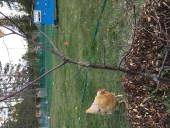okay, first of all, just let nature take its course and stop worrying
if they're struggling,. don't replant them now since you might kill them of by doing so. and if they are already dead, you've wasted time. First let them sprout and do their thing. chestnuts are very hardy [once established] and can be coppiced to the ground back and will happily come back.
if you than later decide to replant, which i think the chestnuts will not like, then the only thing that would make sense to me is to dig out one cubic meter of clay, mix half a cubic meter with sand and then put back, and put them on a mound of like 30 cm to help drainage. but that seems like a hell of a job. it's all about drainage with chestnuts, which is why they don't like stagnant valleys but grow mid-slope.
you see in EU there is a lot of disease, mainly the blight and the ink disease, and chestnut groves in clay soil they are completely wiped out. on their natural turf they have much more resistance. whatever you may have heard, there is no such chestnut that is 100% resistant to blight or ink disease. At least this is what the Aveyron Conservatoire Régional du Châtaignier, which seems to be the only conservatory in the EU (although you would have thought there would be some in the Ardeche or Cevenne), told me when i visited a few days ago.
by the way, I'm assuming you are talking about some american/chinese hybrid?
Also, I'm talking from the point of view of my knowledge of the european chestnut, the sativa, and their japanese hybrids, but I'm assuming the information would equally apply.
A final point, sometimes trees just don't work out, maybe it was the plants, maybe your place, maybe some untimely event. Don't worry, just try again and investigate what might have been wrong.
edit: okay now i see, they are leaving out already. good, don't move them now. normally comfrey really won't be a problem for a chestnut, but you can always cut comfrey back for some mulch.





